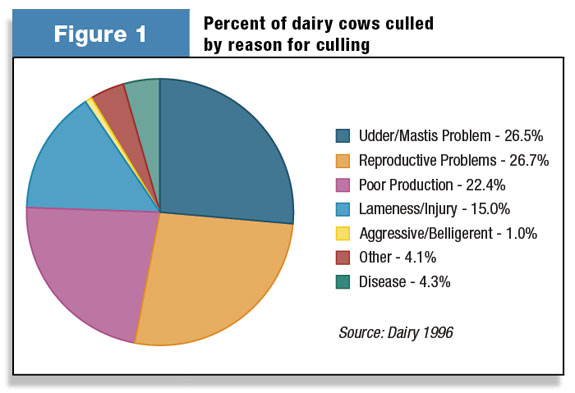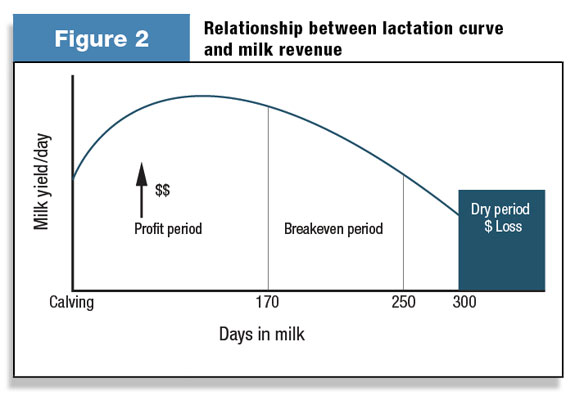TRENDING TOPIC ARTICLE: A.I. & BREEDING Originally published: Nov. 19, 2009 Since we began tracking trending topic articles, we’ve been surprised with the number of “older” articles that remain well-read. Case in point is this 2009 article from the Dairy Cattle Reproduction Council (DCRC), which pointed out five areas dairy producers should consider when deciding whether to cull an animal for reproduction: long calving intervals, high somatic cell count, poor reproduction health postpartum, difficult calving and lower fertility. to jump to the article. Because this article has been so popular, we asked DCRC a follow-up question: Q. Which one of the five areas highlighted in the article for producers to consider when culling cattle most influenced dairymen in 2011? I believe the high cull price influenced some dairymen to cull cows that they may have held on to. But ultimately, lack of pregnancy, injury/other and mastitis usually are the three greatest causes for culling. Jeff Stevenson Vice President, Dairy Cattle Reproduction Council Professor, Kansas State University

ARTICLE
Dairy producers face difficult decisions every day. One of the toughest is deciding whether to keep and treat or cull a cow. Dairy producers choose to market dairy cattle for a number of reasons, whether reproduction, poor milk quality, low milk production, lameness or a number of other possibilities.
Studies show that 26.7 percent of producers culled cattle because of reproductive issues (see Figure 1 ), making it the most prevalent reason for culling dairy cattle.
Producers with a good reproductive program create an optimal dairy environment, managing income losses caused by long days open and reducing reproductive culling.
This article will review some considerations that dairy producers should take into account when deciding to cull dairy cattle for reproduction. There are five areas dairy producers should consider when deciding whether to cull an animal for reproduction. They include:
Long calving intervals
Economic analysis shows that calving intervals extended beyond 13 months result in reduced annual revenue.
High SCC
Studies have shown that high somatic cell counts (SCC) have a dramatic effect on reproductive efficiency.
Poor reproduction health postpartum
Cows that experience metabolic disorders after calving can have long-term damage to the reproductive tract, resulting in infertility.
Difficult calving
Damage to the uterus can take place during a difficult calving. At times the damage can be too critical to repair and can cause future reproductive problems.
Low fertility
The higher the number of services per conception, the less fertile the animal. Each day cows stay open past the voluntary waiting period costs the dairy producer money.

Long calving intervals
A recent economic analysis showed that, regardless of the use of rBST, an extended calving interval of more than 13 months results in decreased annual revenue per cow. Milk production loss is incurred with extended calving intervals, resulting in lost profits.
This is illustrated in Figure 2 . After cows reach peak milk production, they are no longer profitable to the herd.
Once cows reach the “breakeven point,” they are producing an amount of milk that equals the cost of production. The more often a cow becomes pregnant during her productive lifetime, the more profitable she is.
If producers are having a difficult time getting cows rebred and cows are freshening with greater than a 16-month calving interval, culling is advantageous compared to the additional costs of housing, care and feed when cattle are not bred and are producing fewer pounds of milk.
High somatic cell count
High somatic cell count (SCC) and mastitis reduce milk production and are a large reason for producers to cull dairy cattle. Mastitis not only decreases milk production, but also impacts reproductive performance.
Mastitic dairy cattle have a higher body temperature and their immune response is suppressed, resulting in decreased embryonic development.
Numerous studies have indicated there is a direct correlation between high SCC in cows and poor reproductive performance. One study concluded dairy cattle experiencing mastitis between calving and first service have more services per conception, increasing days open and calving interval.
Cows experiencing mastitis early in lactation had an average days in milk (DIM) of 75.7 to first conception versus cows not experiencing mastitis with an average of 67.8 DIM.
Furthermore, cows infected with mastitis have a higher incidence of abortion between 45 and 150 days after conception, regardless of time of infection.
Chronic mastitis events that go untreated represent a large risk to dairy producers. Not only are they generating less revenue through decreased milk production and reduced milk quality, but reproduction losses also represent an increase in costs.
Culling dairy cattle because of mastitis and high SCC is the second-most prevalent reason for culling, but could also be considered an indirect cause of reproductive culling.
Poor reproduction health postpartum
After calving, dairy cattle are most susceptible to reproduction problems. Many of these problems can lead to infertility, which makes good management practices critical. The most frequent calving disorders include retained placenta, metritis, cystic ovaries and anestrus, all of which, if not managed properly, can lead to reproductive failure. If a cow does not expel her placenta within 12 hours after calving, it is considered a retained placenta.
Nonspecific infections during pregnancy and calving can cause retained placentas, while other causes include twins, abnormal deliveries and caesarian sections. When a dairy producer notices that a cow has not expelled her placenta, attention should be paid quickly.
If a retained placenta goes untreated it could lead to metritis. Incidences of retained placentas should not exceed more than 8 percent of calvings in a herd.
Another problem often experienced postpartum is cystic ovaries. Ovarian cysts are structures, usually greater than one inch in diameter, that stay in one or both ovaries for 10 days or more. Fertility is greatly reduced due to hormonal changes in the dairy cow, changes in the uterus and failure to release an egg.
Cystic ovaries are often genetically inherited and dairy producers can reduce their incidence through selective culling of animals known to produce daughters with cystic ovaries.
Cows that do not show signs of estrus are considered anestrus, which can be a result of cystic ovaries – studies show 70 percent of cystic cows are anestrus. Uterine infections can also be the cause of an anestrus cow, and if untreated, days open increase and dairy producers lose revenue.
Difficult calving
Calvings such as abnormal and prolonged deliveries, twinning, forceful pulling and prolapsed uterus can lead to damage and rips in the uterus. Major injuries of the uterus and reproductive tract can cause infections and infertility. After a difficult calving, cattle should be monitored for infections.
If dairy producers notice cattle not showing signs of estrus or showing signs of infertility, they should work with their veterinarian to discuss further actions such as treatment, culling or marketing the animal.
Low fertility
Many of the considerations above relate to reduced or low fertility, a major reason for culling dairy cattle. Dairy cow fertility can be defined as the percentage of cows that conceive at first service, also known as the conception rate per artificial insemination (A.I.). Recent reviews have shown a drastic decrease in dairy cattle fertility rates.
Conception rate per A.I. has decreased from 66 percent in 1951 to about 50 percent in 1975, down to 40 percent in 1997 and still decreasing today. Cows with low fertility increase a producer’s costs on a daily basis. These cows typically require more services per conception, resulting in longer days in milk and increased semen costs.
Dairy cows beyond their fifth service have a greatly reduced chance of getting pregnant, and cows beyond 150 days in milk typically have reached their peak milk production, are increasing body condition and are difficult to get rebred. Cows with days open extending beyond 175 days in milk should be considered as candidates for culling.
With an increased need for proper management decisions and demand for high-quality milk, determining the best time and reason for marketing cattle is critical. Culling dairy cattle is an issue dairy producers must address every day, and choosing to cull a dairy cow for reproduction is the most common reason.
If reproductive culls become an issue, consult your nutritionist and veterinarian to identify solutions to improve your reproductive program. PD
Click here to email an editor for references which have been omitted due to space.
—Excerpts from Dairy Cattle Reproduction Council newsletter, Vol. 3, No. 4





